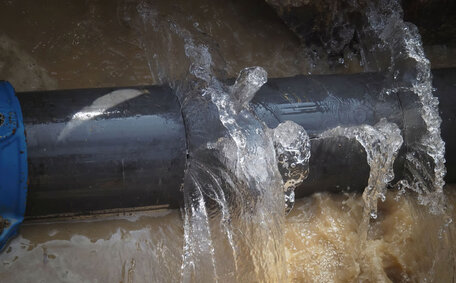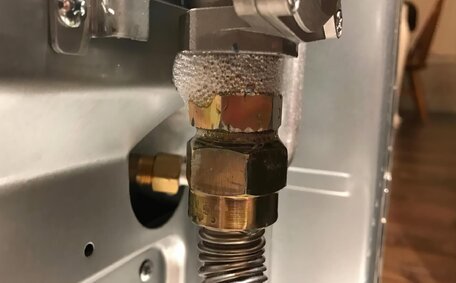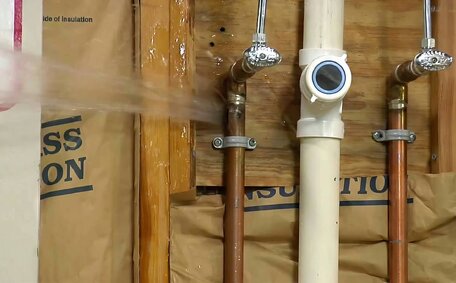Introduction to Pipe Relining
Pipe relining is a trenchless plumbing solution that renews pipes without the need for expensive and messy excavation.
It involves coating the inside of degraded pipes with a structural polymer lining to essentially create new pipes inside the old ones. At Randwick Plumbing, we specialise in pipe relining for the residents and businesses of Randwick, Sydney and have performed numerous successful relining projects over the years.
When it comes to pipe relining, one common question we receive is: what is the minimum pipe diameter required for the relining process? The answer depends on a few key factors.
In this article, we will cover everything you need to know about pipe sizes for relining, including the capabilities of the process for small and large diameter pipes, how relining affects water flow, as well as address some other frequently asked questions about relining existing pipes of varying dimensions.
We will elaborate on Randwick Plumbing’s expertise in assessing which pipe types work for relining, determining the thickness of polymer lining needed, and tailoring the process for each customer’s unique plumbing infrastructure. As trusted local plumbers, We want to ensure pipe relining improves all your plumbing and safeguards your property for years to come.
Understanding Minimum Diameter Requirements
When it comes to pipe relining, there are certain industry standards and regulations regarding the minimum pipe diameter suitable for the process. These requirements exist to ensure the relining is effective and does not impede water flow rates after completion.
The minimum pipe diameter considered viable for relining is typically 50mm or 2 inches. This accounts for the thickness of the epoxy polymer lining applied to the interior pipe surface. After the lining is applied, the diameter may be reduced, but generally remains large enough to allow adequate water flow.
At Randwick Plumbing, we adhere to industry regulations and best practises when assessing old pipes for relining suitability. During our onsite inspections, we carefully examine the diameter of all your existing pipes. If the diameter falls below 50mm, we generally cannot recommend relining since the lining application would restrict water flow too severely.
However, for some small diameter pipes we may propose alternate solutions, like replacing a section of piping with new, wider pipes to enable relining of adjoining sections. We take a consultative approach, exploring all options to find the best plumbing solution for your unique situation.
Typical Pipe Sizes Used in Homes and Businesses
When it comes to residential and commercial plumbing, there are some standard pipe diameters commonly used:
- 15mm (1/2 inch) - Often used for taps, sinks, and appliance connections
- 20mm (3/4 inch) - Common for taps, sinks, basins and some appliances
- 25mm (1 inch) - Typically used for kitchen taps, vanities, dishwashers and washing machines
- 32mm (1 1/4 inches) - Common for bathroom hand basins and laundry tubs
- 40mm (1 1/2 inches) - Standard for showers, bathtubs and toilets
- 50mm (2 inches) – The minimum size for relining, used for some toilets and main branch lines
- 65mm to 80mm (2 1/2 to 3 inches) – Common for main drain lines under floors and in walls
- 100mm (4 inches) and up – Usually external drainage pipes
As you can see, 50mm is the typical minimum diameter our technicians at Randwick Plumbing can work with for pipe relining projects. Smaller pipes like 15-25mm are generally too narrow for the process.
Larger drain lines of 65mm and up make ideal candidates for trenchless relining. We have the experience to coat pipes up to 300mm in diameter with epoxy polymer linings to restore their structural integrity.
Smallest Pipe Diameters that Can Be Relined
As mentioned previously, the generally accepted minimum pipe diameter for relining is 50mm or 2 inches. However, with recent advances in relining technology and materials, pipes smaller than 50mm can sometimes be relined by experienced technicians like those at Randwick Plumbing.
We have successfully relined pipes as small as 40mm in diameter. We have successfully relined pipes as small as 40mm in diameter. At such small diameters, the relining polymer lining takes up a larger relative percentage of the pipe’s cross-sectional area. This reduces the area open for water flow, which could cause drainage issues.
Applying an even, structurally sound lining over numerous bends becomes more difficult in narrow pipes below 40mm. The technical skills and custom equipment needed to work in such confined spaces makes small pipe relining more complex.
So while 50mm remains the industry standard minimum diameter, Randwick Plumbing now has the capability to reline pipes from 40mm to 225mm in diameter. Our extensive local experience allows us to evaluate the unique aspects of your property’s plumbing to determine if smaller pipes are candidates for trenchless relining.
We stay up to date on the latest advances in relining materials and techniques. Over the years we have invested in specialised pipe inspection cameras and application equipment to coat pipes as small as 40mm while minimising flow disruption. Contact our team today to learn if your small diameter pipes qualify for trenchless relining.
How Relining Affects Pipe Diameter and Flow Rate
When pipes undergo relining, a protective epoxy coating is applied to the interior surface. This polymer lining is generally around 3-5mm thick for standard drain lines. So a 100mm pipe, for example, may have its diameter reduced to 95mm after relining.
There is sometimes concern that this reduction in overall pipe diameter will impede drainage flow rates. However, we’ve found the flow impact is usually negligible and pipe capacity remains more than adequate after relining.
Why is this the case? The answer lies in fluid dynamics.
Drainage pipes don’t typically run full—the water level usually only partially fills the pipe, even during peak flows. More importantly, the smooth epoxy lining actually helps improve flow. Old pipe walls are often irregular and corroded, creating turbulence in drainage water. The slippery polymer relining minimises this turbulence, offsetting any minor reductions in pipe diameter.
Our experienced Randwick Plumbing technicians can advise if pipes at your property could benefit from relining and ensure any effects on pipe diameter and drainage flow rates are considered during the process. We cater the polymer thickness and application technique to your site’s unique piping layout.
In summary - yes, relining marginally decreases overall pipe diameters. But the potential impacts on flow are negligible thanks to the slick inner pipe surface. And relining remains far less invasive and costly than digging up and replacing ageing plumbing.
Step-by-Step Overview of the Relining Process
At Randwick Plumbing, we take a meticulous approach to pipe relining. Here is a step-by-step overview of what this process involves:
Inspecting the Pipes
First, our technicians perform a thorough pipe inspection using a specialised drainage camera. This allows us to assess the location, length and diameter of your pipes and identify any problem areas needing repair.
Cleaning the Pipes
We use localised high-pressure water jetting to clean out any accumulated debris, grease or grime lining the pipes. This prepares them for the reline application.
Applying the Epoxy Lining
A two-part epoxy resin is mixed and used to coat the interior pipe walls. Our relining crew then uses air pressure to ensure the lining adheres properly within the pipe. The epoxy cures to form a smooth, seamless lining.
Final Testing & Inspection
Once the lining has set completely, we thoroughly inspect the pipes using cameras and pressure testing. We check for any defects, leakage or potential flow issues. This quality assurance process is a key part of our service.
Preparing the Pipe Through Cleaning and Inspection
Before any relining project, preparing the pipes through comprehensive cleaning and inspection is a crucial first step. At Randwick Plumbing, we invest in specialised equipment to properly cleanse and evaluate pipes prior to applying epoxy coatings.
Using localised high-pressure water jetting, we thoroughly clean the interior pipe walls to remove decades of grime buildup and debris from all your pipes. Rotating nozzles emitting pressurised water help scour the pipe’s entire perimeter down to the bare subsurface.
We then conduct detailed pipe inspections using our remote-operated CCTV drainage cameras. Assessing the pipes’ structural condition, diameter, length and exact layout allows us to develop custom relining strategies tailored to all your unique plumbing infrastructure.
Catching any severely damaged sections of pipe beforehand also gives us a chance to repair major leaks or breaches prior to applying the internal pipe coating. Our combined cleaning and inspection regimen paves the way for smooth, effective long-term relining for all your pipework.
Installing the New Pipe Liner
Once all your pipes have been thoroughly cleansed and assessed, we progress to installing the new protective liner. Our technicians use a felt fibreglass sleeve soaked in specialised two-part epoxy resin. This flexible liner is fed through the piping network, conforms to bends, and spans the full length to be relined.
Air pressure gently inflates the liner until it presses evenly against pipe walls. We maintain this pressure as the liner cures for several hours, ensuring optimal adhesion. The smooth polymer lining provides a robust protective barrier, sealing cracks and fillings gaps for decades.
Compared to traditional pipe materials, the seamless epoxy coating is corrosion-resistant, structurally reinforced, and allows for efficient water flow. It also safeguards surrounding infrastructure by preventing leaks. At Randwick Plumbing, we handle the entire precision relining process using industry-leading techniques and technology.
Curing the Liner and Reconnecting Services
Once our relining technicians have finished installing the epoxy polymer liner within the pipes, an important curing period allows the liner to harden fully. We maintain air pressure within the piping network to hold the flexible liner firmly against the interior walls until the specially formulated resin chemically cures.
This curing process generally takes between 2 to 4 hours. Our team closely monitors pressure levels and follows strict quality controls to ensure optimal results. Over this period, the liner transforms from a flexible felt material into a rigid, seamless barrier.
With the sturdy epoxy layer now fused smoothly along your home or building’s plumbing, we move to the final step—reconnecting existing water services without excavation. Your property’s drainage system may interface with appliances, fixtures and sections of galvanised piping. We take care to reconnect each one.
Using remote-controlled robotic cutters, small openings are carved into the liner at connection points. Your services are then thread back through and pressure tested to check for leaks. All work is conducted inline with Sydney Water standards.
Contact Randwick’s most trusted plumbing specialists to learn more about our full suite of professional relining services. We offer hassle-free solutions to restore your pipes without the mess and costs of traditional pipe replacements.
Comparing Cost: Relining vs. Full Replacement
When weighing up trenchless pipe relining against full replacement, cost is often a major factor. At Randwick Plumbing, we recognise that plumbing solutions must not only be effective, but affordable.
Full pipe replacement requires excavators to dig access holes, remove old pipes, install new ones, backfill trenches and resurface. There are fees for equipment, labour, materials and restoring your property. Indirect costs like business downtime or accommodation during repairs can also add up.
Pipe relining avoids this disruption. Our technicians access pipes via small openings, reinforce them from the inside then reseal surfaces. Without breaking ground, expenses are minimised.
An indicitive cost comparison is:
- Full replacement of 40m of 100mm pipe - $15,000+
- Relining the same 40m section - $6,000 to $8,000
As experienced plumbers providing services in the Randwick area, we aim to tailor the most cost-effective solutions whether you’re a homeowner, landlord or manager of commercial premises.
Contact our team to receive an accurate quote. We can arrange no-obligation onsite inspections assessing if pipe relining can save you money compared to full replacement.
Hiring a Professional for Assessment and Installation
Attempting pipe relining without professional expertise and equipment can lead to botched jobs and potential plumbing disasters. At Randwick Plumbing, our licenced technicians have years of hands-on experience assessing candidate pipes for relining and performing successful installations.
The relining process involves specialised cameras, high-pressure jet cleaners, custom-calibrated epoxy pumping systems, and more. Proper training is needed to operate this equipment and apply durable linings that won’t delaminate or crack over time.
Equally important is diagnosing which pipes qualify for trenchless relining in the first place. Our experts examine diameter, corrosion levels, layouts and existing joinery to determine viability. We also ensure compliance with Sydney Water requirements and manage permissions for apartment blocks and strata properties.
By leveraging our expertise, locally-compliant equipment and industry relationships, we safely deliver quality pipe relining outcomes for residential and commercial customers. Don’t leave it to chance with DIY experiments - partnering with seasoned professionals like Randwick Plumbing is critical for such technically-involved plumbing projects.






